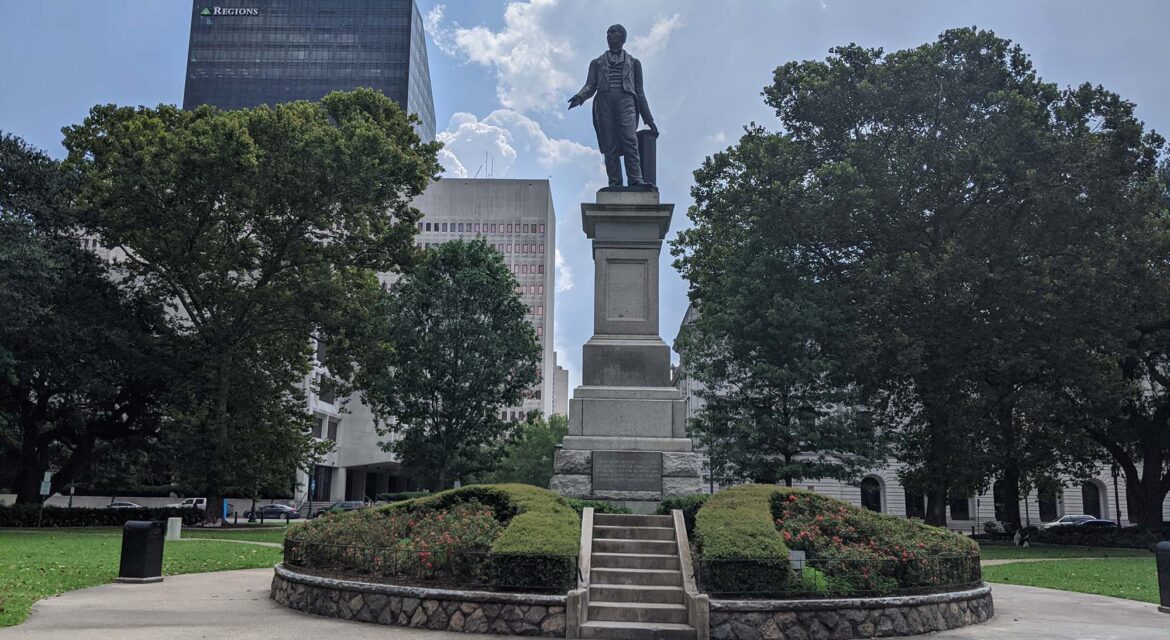 As the site for inaugurations, yearly pilgrimages by school bands, jazz concerts and various other events for over two centuries, Lafayette Square has become an essential element of the community in New Orleans, Louisiana. The second oldest square in the city has been able to compel different types of activity and engagement with audiences to cultivate a true sense of community that has evolved within the square and throughout the city.
As the site for inaugurations, yearly pilgrimages by school bands, jazz concerts and various other events for over two centuries, Lafayette Square has become an essential element of the community in New Orleans, Louisiana. The second oldest square in the city has been able to compel different types of activity and engagement with audiences to cultivate a true sense of community that has evolved within the square and throughout the city.

From Place Gravier to Lafayette Square
 Designed in 1788 by Charles Laveau Trudeau, Lafayette Square was originally known as Place Gravier. It was renamed when one of the heroes of the Revolutionary War, the Marquis de LaFayette, visited the city in 1825. The 2.5-acre park is setup across Gallier Hall, which is the former seat of city government. This helped to give prominence to the square in the early days of the city.
Designed in 1788 by Charles Laveau Trudeau, Lafayette Square was originally known as Place Gravier. It was renamed when one of the heroes of the Revolutionary War, the Marquis de LaFayette, visited the city in 1825. The 2.5-acre park is setup across Gallier Hall, which is the former seat of city government. This helped to give prominence to the square in the early days of the city.
The Lafayette Square Historic District has been and continues to be defined by Lafayette Square, which features early residential buildings that exhibit characteristics of the Federal style, relatively uncommon in New Orleans. The center of the square is dominated by a bronze statue of Henry Clay that was erected in 1856 on Canal Street but moved to the square in 1900. Other prominent statues in the space depict John McDonogh and Benjamin Franklin.
Lafayette Square suffered major damage in 2005 from Hurricane Katrina, which destroyed many of the trees and littered the area with garbage. To revive the square into an urban sanctuary, residents and downtown workers came together to form the Lafayette Square Conservancy. Their goal was to ensure the space would be a well-maintained public park that serves as an urban oasis for visitors, residents and people in the surrounding neighborhood.
The fact that people came together in such a profound way to preserve and protect Lafayette Square speaks to the notoriety that it has established. Doing so is ultimately the result of so many distinct experiences for visitors that are actively enabled by the community.

Defining the Heart of the Central Business District
Lafayette Square is at the heart of the Central Business District in New Orleans, which is a mixed-use neighborhood that features everything from skyscrapers to neighborhood retail stores along with numerous restaurants and clubs. By being able to do anything from attend organized events to interact with actual history to relax on the grass, Lafayette Square has been able to provide both residents and visitors with a variety of activities that have helped generate interest and economic opportunities from across the region.
 Lafayette Square is host to the Wednesdays at the Square, a free summer concert series featuring top names in local acts. It is also home to a fall blues music festival as well as weddings, corporate events, filming, and parade-watching during Mardi Gras.
Lafayette Square is host to the Wednesdays at the Square, a free summer concert series featuring top names in local acts. It is also home to a fall blues music festival as well as weddings, corporate events, filming, and parade-watching during Mardi Gras.
While the statues of Henry Clay, John McDonogh and Benjamin Franklin dominate the space, various other pieces of part, historical markers and sculptures are contained in Lafayette Square. They range from markers dedicated to a former mayor of New Orleans to the modern “Bunny” sculpture by Tara Conley. All of these distinct attractions and activities have enabled the creation of businesses that utilize their proximity to Lafayette Square to further attract and engage these audiences.
The Lafayette Square Conservancy regularly hosts planting and clean-up days. All of the statuary bed and seasonal plantings in the park are done by the dedicated volunteers of the organization. These efforts along with the prominent placement of the square in maps and guides of the city highlight what can happen when a community connects with and actively utilizes monuments like Lafayette Square.

The Legacy of a Community
 Just as the city around it has evolved over the centuries, so has Lafayette Square. This continued evolution has enabled the space to form a close connection with the surrounding community by utilizing the history, events and activities that have come to define the square. These developments have ensured that the legacy Lafayette Square represents will continue to evolve in a meaningful way for audiences and for the city of New Orleans.
Just as the city around it has evolved over the centuries, so has Lafayette Square. This continued evolution has enabled the space to form a close connection with the surrounding community by utilizing the history, events and activities that have come to define the square. These developments have ensured that the legacy Lafayette Square represents will continue to evolve in a meaningful way for audiences and for the city of New Orleans.

